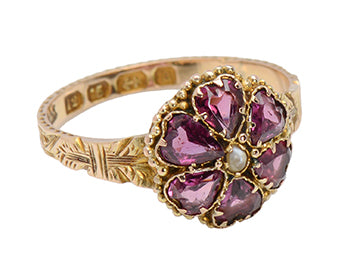
Clues to dating! When you find an English hallmark of 12k gold you have a pointer about dating that piece of antique jewelry. In the British Isles, this standard was only in use from the years spanning 1854 until 1932.

(Our photo above is of the inside of the shank of an antique English ring. This is an example of the hallmarks that might be found on a piece of gold jewelry. This ring was made in the year 1868, made in Birmingham, from 12k gold. )
After that, it was eliminated entirely. Still in use were 9k gold, as well as 18k and 22k. However, 15k gold was discontinued and replaced by 14k.
Most commonly, you may find these marks on sturdier rings or lockets, and other pieces that could hold up to the many lead punches used to impress these marks. Small and thinner items were exempt from stamping if these actions would damage them. You might see the "12" mark or .5 mark, or both.
So, the fine print to dating this way, particularly for rings, is to know the dates 12k (12ct) was utilized.
But be aware that a shank (or band) may have been replaced. You would need a jeweler's loupe to detect this. In other words, the shank could date to these years if 12k gold (1854-1932), but was later added to a top with an entirely different date, younger or older.
Some questions answered...
Is 12k gold real? It sure is. Just like 14k, or 10k, all of these are part gold and part alloys or a mix of metals. The higher the karat (carat) the more gold content with 24k or karat, being pure gold.
What is the value of 12k gold? The value will be above that of 10k gold, and below 14k. There are many online calculators to help you determine the value of a particular piece of jewelry that has an exact karat of gold if you know the precise weight of it in grams (gm) or pennyweight (dwt).